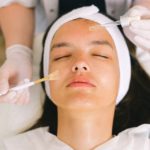Chemical Peeling
What is A Chemical Peel and Its Types?
A chemical peel is a treatment procedure used to improve the appearance of the skin. A chemical solution is applied to the skin that causes it to exfoliate and eventually peel off. The new, regenerated skin is usually smoother, has less visible skin pores, and is less wrinkled than the old skin. The new skin is also temporarily more sensitive to the sun and other rejuvenating procedures. So, wearing a suitable sunscreen is highly recommended for all outdoor activities.
There are two chemical peels: Aesthetic chemical peel and medical peel.
Aesthetic Chemical Peeling:
Very superficial Depth Aesthetic Peel: Alpha-hydroxy acid or another mild acid like Beta Hydroxy Acid is used to penetrate only to the superficial layers of the epidermis to mildly exfoliate it. This is a good choice for improving the appearance of skin and preparing the skin for absorbing the daily routine skincare products and helping the skin to fight with very fine wrinkles and mild skin discoloration. This is a good complementary method for other rejuvenating procedures. Clients should become mindful of the importance of wearing sunscreen.
Medical Chemical Peeling:
Superficial Depth Peeling: Alpha-hydroxy acid or another mild acid is used to penetrate only the outer layer of skin to gently exfoliate it. The treatment is used to improve the appearance of mild skin discoloration and rough skin as well as to refresh the face, neck, chest, or hands.
Medium Depth peeling:
Glycolic Acid [GA] or trichloroacetic acid [TCA] is applied to the skin to penetrate the out and middle layers of skin to remove damaged skin cells. The treatment is used to improve age spots, fine lines and wrinkles, freckles, and moderate skin discoloration. It also can be used to smooth rough skin and some skin disorders/diseases.
Deep Depth peeling:
Trichloroacetic acid or phenol is applied to deeply penetrate the middle layer of skin to remove damaged skin cells. It needs a reliable appropriate anesthetic method to be performed before the procedure. Normally, it is done in the hospital. The treatment removes moderate lines, age spots, freckles, and shallow scars. Patients will see a dramatic improvement in skin appearance. The procedure is used on the face and only can be performed once.

What should first be done before considering a chemical peel?
A complete consultation and evaluation by a medical aesthetician is imperative before approaching to a chemical peel.
What are the complications or potential side effects of a chemical peel?
Temporary or permanent change in skin color, particularly for women on birth control pills, who subsequently become pregnant or have a history of brownish facial discoloration.
Scarring
Reactivation of cold sores
What can I expect after having a chemical peel?
All peels require some follow-up care:
Very Superficial peels require one to seven days to heal. Treated skin will initially be red and may scale during a week after the procedure. Simple moisturizing cream [Pure Vaseline] should be applied until the skin heals, followed by daily and regular use of sunscreen SPF 15-30[Physical Sunscreen is preferred]. Makeup can usually be worn the next day.
Superficial peels require Seven to ten days to heal. Treated skin will initially be red and scale during a week after the procedure. Simple moisturizing cream [Pure Vaseline] should be applied until the skin heals, followed by daily and regular use of sunscreen SPF 30[Physical Sunscreen is preferred]. Makeup can usually be worn the next day.
Medium depth peeling only performing by a Physician and requires seven to 14 days to heal. Treated skin will initially be inflamed(red), Irritated and oedematose. Edema and Irritation worsens for the first 3 days. Eyelids may swell shut. Sometimes, blisters may form and break. Skin crusts and peels off in ten to fourteen days. Skin must be soaked daily for a specified period, followed by ointment application. Antiviral medication is taken for 10 to 14 days. Mild lotion or cream may be applied. Avoid all sun exposure until healing is complete. Camouflage makeup may be worn after 10 days. A follow-up appointment will be necessary to monitor progress.
Deep Depth peels performing by a physician /Dermatologist and requires 14 to 21 days to heal. Normally, the treated skin will be bandaged. Skin must be soaked four to six times daily, followed by ointment application for the first 14 days. Afterwards a thick moisturizer is applied for the next 14 days. Antiviral medication is taken for 10 to 14 days. Mild lotion or cream may be applied. Avoid all sun exposure for three to six months. Camouflage makeup may be worn after 14 days. Several follow-up appointments will be necessary to monitor progress.
Various Tanning methods, sun exposure and smoking, and other irritating and inflaming procedures or products prohibited after a chemical peel because they can cause adverse effects and complications, including infection and leaving a scar tissue.
